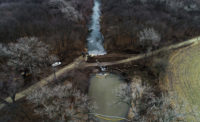Nearly three weeks after Superstorm Sandy hit the New York, New Jersey and Connecticut coastline with an unprecedented combination of wind and storm surge, public-private teams have largely dealt with power outages and flood emergencies and now are turning their attention to damage in infrastructure and to longer-term restoration, debris cleanup, structural assessments and housing for the thousands who were displaced.
The U.S. Army Corps of Engineers, which says it tapped many of its 3,000-plus staff in the North Atlantic Division, along with nearly 1,000 from other locations since the storm hit on Oct. 29, reported on Nov. 20 that it had completed unwatering at 14 key sites, removing more than 275 million gallons using 162 pumps with help from local authorities and contractors. The Corps also said that 35 debris teams assisting officials in hard-hit New York and New Jersey municipalities have removed 59,422 cu yd of debris. On Nov. 15, the division awarded three task orders totaling $92 million for debris removal in New York City to Burlingame, Calif.-based Environmental Chemical Corp. A Corps official says ECC will hire local subcontractors to perform most of the work.
Amtrak restored service to the last of its four severely flooded New York City tunnels. The railroad's north Hudson River tube took on several feet of water in and around the site as well as in adjacent properties, damaging circuit breakers and electrical systems, says spokesman Cliff Cole. Service was restored to the tunnel on Nov. 16, he adds. High winds and flooding affected signals and electrical systems on the four 102-year-old tunnels.
The south Hudson River tube and two of Amtrak's four East River tunnels were scheduled for repairs ahead of the north tube, Cole says. The south tube did not sustain as much damage, he says, and so it was easier to restore modified service from NYC to points south, he says.
However, East River tunnels, which took on 7.5 million gallons of brackish water from the storm, are the main access points for Amtrak and commuter lines between Manhattan's Pennsylvania Station and rail yards in Queens. Both facilities lost power, freezing trains in place, Cole says. The north tube's Nov. 16 service restoration was ahead of expectations, he says. Cole could not provide the date for when the north tube was initially forecast to be restored. "Originally, we had expected [the restoration] to take two to three weeks, but from when we got in to inspect the property, we were able to get it on line [faster than that]," he adds.
Overall, damage to the Northeast Corridor "was significant and, in some places, unprecedented," with nine miles of line between Manhattan and Albany, N.Y., flooded to just below track level, Cole says. Problems in New Jersey included roof damage at Princeton Junction and flooding at the Trenton station. Elsewhere, water infiltrated the K Tower at Washington, D.C.'s Union Station.
The storm also flooded the Amtrak-owned electrical substation in Kearny, N.J., affecting the signal and switching system between New York City and Newark. NJ Transit and Amtrak completed repairs at the substation on Nov. 16.
But New Jersey Transit customers are still coping with incomplete service on some key commuter lines, with damage to one-third of its locomotives and 25% of its rail cars, particularly those stored in low-lying sites in Kearney and Hoboken that suffered seawater flooding up to 8 ft high, according to published reports. The inundation also shorted backup power and emergency generators.
Some PATH rail service between New Jersey and New York City also remained out as of Nov. 20, with damage at stations on both sides of the river, says Steve Coleman, a spokesman for the Port Authority of New York & New Jersey, which operates the line. Crews are repairing signal systems and other electrical infrastructure, he adds. The agency was able to re-open shipping terminals in Port Newark and Jersey City on Nov. 5, despite taking on nearly 4 ft of water from storm surges. "Round-the-clock cleanup efforts have repaired damaged roadways, hundreds of displaced shipping containers, [and] fixed rail lines, damaged electrical systems and other port cargo," the agency said in a statement.
Meanwhile, one of the most "worrisome" concerns after any infrastructure takes on saltwater is its effect on electrical systems, says Jeffrey Levy, president and CEO of engineering firm RailWorks, New York City, which is assessing subway damage at some locations for the city's Metropolitan Transportation Authority (MTA). "When you submerge things in water, it's bad," Levy says. Dried salt from seawater is highly corrosive to electrical components, he adds.
To provide service to the especially hard-hit Rockaway Peninsula in the city's Queens borough, MTA says it has set up a temporary shuttle-train service while the area's disabled line faces several months of repair. Subway workers partially dismantled older, 60-ft-long, 80,000-lb subway cars for use as part of free shuttle service in the area that began operations on Nov. 20. "The reconstruction of the Rockaway Line between Howard Beach and the South Channel Bridge will be a tremendous undertaking," Thomas F. Prendergast, NYC Transit president, said in a statement. "While media attention has been focused on the flood damage to our under-river tubes, we also suffered severe damage along our outdoor lines. The Rockaway Line was especially hard hit and will require additional time to repair."
Also sustaining flooding damage is New York City's harbor "siphon," an estimated $250-million water tunnel between Brooklyn and Staten Island that will replace two shallower lines, which will be removed because they would impede harbor dredging. According to industry sources with ties to the project, saltwater in the pipeline tunnel damaged electronics on its tunnel-boring machine, immobilizing it.
"The project sustained flooding, and we are working with our contractors and the manufacturer of the tunnel-boring machine to assess any and all damage to the machine," says a spokesman for the city's Economic Development Corp., which is managing the project. "Once this process is complete, we will begin to take the steps required to safely and expeditiously continue with the project as planned." He did not give details on the damage or indicate a time frame for the assessment or project startup. The project was set to be completed in 2014.
Also working to come back from flood impact is the Passaic Valley Sewerage Commission's wastewater treatment plant in Newark, which officials said was inundated by up to 200 million gallons of water. "We were hit by a four-foot wave," says the facility's chief engineer, John Rotolo. "It's the worst impact the commission has seen in 100 years."
Serving 1.5 million customers, the state's largest such facility is not yet up to full treatment operation and had been discharging untreated and partially treated wastes into nearby waterways since Sandy struck. Rotolo says the plant was beginning sludge treatment during the week of Nov. 19. He says that while 300 motors were rehabilitated, he noted the flood impact could still reduce "the life span" of facility equipment.
Rotolo did not estimate the damage or repair costs. But he says the commission and its consultants now are assessing how to reduce future flood risks in relocating critical equipment and other steps.
Meanwhile, New York City is reaching out to the construction industry with a new "rapid repairs" program, announced on Nov. 9, to help homeowners rebuild.
Subsidized by the Federal Emergency Management Agency, the program will send teams of contractors and inspectors into storm-damaged neighborhoods, says Mayor Michael Bloomberg. Unlike the typical FEMA process in which homeowners individually hire contractors, homeowners who sign up for the program at the city's website, www.nyc.gov, will be served by teams working through the city.
The Building Trades Employers Association (BTEA) of New York City is facilitating the effort, hosting a registration form on its website. "The current plan is to divide the city into three or four geographic areas, with a program manager for each," says Louis J. Coletti, BTEA president and CEO. He says about 400 firms have registered on the site and that the city soon will identify about six to eight firms that will be assigned to manage each of the cleanup areas. "Our desire is to do this with union contractors, but it will depend on the workload," says Coletti. "We are advocating that the management firms be New York City-based." He adds that selected contractors will receive lists of qualified subcontractors from BTEA and from registrants.
While the post-Sandy cleanup mission is larger and more dispersed than what New York City faced after the 9/11 attack at the World Trade Center, "we believe we have the capacity," Coletti says. He says discussions of whether firms will pay federal or New York City prevailing wage rates "are not yet final." Materials supply is another issue the teams have identified and will be addressing, Coletti says. The city is trying to avoid putting people in trailers, he adds, "when we could fix the homes and let families move forward."
The private sector also is pushing efforts to research how regional infrastructure at most risk from storm surges can be bolstered through the use of stronger materials and design.
Noting Sandy's impact on beachfront infrastructure and the resulting economic losses, engineer John Hillman, president of HC Bridge Co., is hopeful that more hard-hit towns might consider his corrosion-resistant engineered material—a hybrid composite beam—when replacing wooden boardwalks and building seawalls and other new barriers that can better withstand forceful surges. He already has had pre-Sandy discussions with officials in Ocean City, N.J.
Hillman says his material is extremely resilient and fared well in blast-resistance tests. "It was tested to three times the design requirements and didn't break," he says. "And we have a concept that looks like a Jersey boardwalk."













Post a comment to this article
Report Abusive Comment